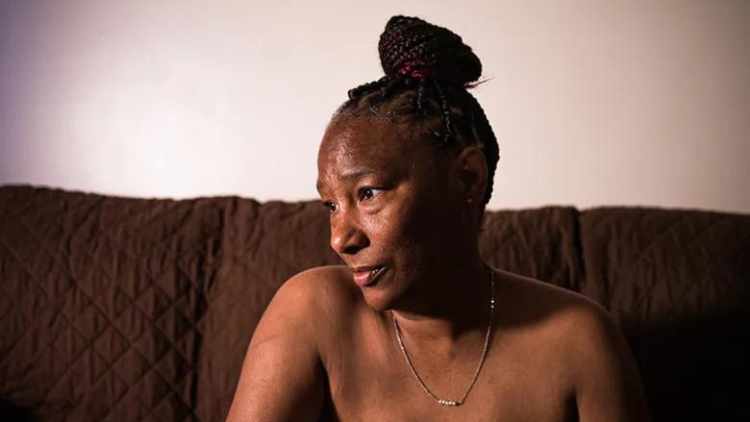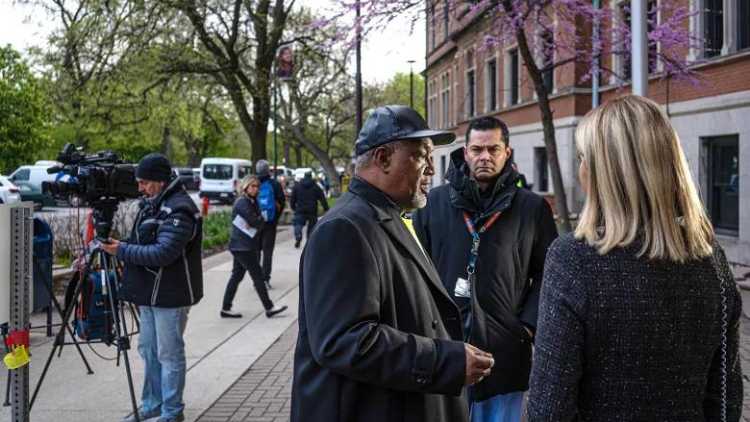A view of Dvorak School of Excellence from the ally near Shantiey Smith and Sadaria Davis went missing. May 10th, 2023. Photo by Sebastián Hidalgo for City Bureau
By
This story is part four of Chicago Missing Persons, a two-year investigation by City Bureau and Invisible Institute, two Chicago-based nonprofit journalism organizations, into how Chicago police handle missing person cases reveals the disproportionate impact on Black women and girls, how police have mistreated family members or delayed cases, and how poor police data is making the problem harder to solve.
When Latonya Moore got home from the police station just before sunrise on May 29 after reporting her daughter Shantieya Smith missing, she was exhausted but unable to sleep. She worried that police didn’t take her report seriously.
“Police weren’t doing what they were supposed to do, so I had to do it on my own,” she says.
She immediately organized a search with family members and friends. They put up fliers in gas stations and stores in the neighborhood and drove around, talking to as many people as they could.
They even checked out the abandoned apartment building where Sadaria Davis had been found dead earlier that month. “We took off the chain. The door was unlocked. There was still her blood on the floor,” Moore remembers. Fearing the worst, Moore and her army of volunteers had brought sticks and bats — but the building was occupied by squatters, and Smith was nowhere to be found.
Meanwhile, Moore wondered why police hadn’t come by to ask her any questions or collect any evidence. She had told officers that Smith had left her phone at home, but days after filing the report, officers still hadn’t picked it up. Desperate for clues, Moore browsed her daughter’s recent calls and text messages — even exchanging several messages and calls with a man who Moore, to this day, believes to be her daughter’s murderer.
On June 4, Moore held a press conference in front of the same police station where she had first reported her daughter missing. With the Rev. Robin Hood by her side, she questioned why police hadn’t made an effort to look for her daughter.
“I’m praying she’s okay,” Moore told WGN 9 News. “I don’t want to think the worst, though.”
Downplaying the case, then-Police Superintendent Eddie Johnson hosted his own press conference 10 days later. “The two young ladies we are speaking about were involved in narcotics sales, prostitution, using narcotics together,” Johnson said, referring to Davis and Smith. Moore says her daughter did not use drugs. City Bureau and the Invisible Institute could not independently verify a connection between Smith and Davis outside of the person with whom they were last seen. The medical examiner later said Smith had no illegal drugs in her body.

Latonya Moore says she hopes police will take missing person cases more seriously, rather than blaming the victims. (Photo: Sebastián Hidalgo)
Nine Black families interviewed for this story said they felt neglected and disappointed in the Chicago Police Department’s handling of their loved one’s missing person cases — services a majority believed were denied because their relatives were Black.
People searching for their missing loved ones felt abandoned and revictimized by Chicago police. In the face of rude behavior, unanswered phone calls, and slow or lackluster investigations where evidence was fumbled or even lost by detectives, friends and family had to conduct their own searches and collect their own evidence.
In worst-case scenarios, people believe police delays and missteps allowed their loved ones to be murdered, leaving perpetrators uncharged or cases unsolved. Moore still wonders if Smith would be alive if police had followed up quickly, examined Smith’s phone, and immediately questioned the man Smith was last seen with.
If you’re Black and you come up missing, nobody cares. – SHIRLEY ENOCH-HILL
Shirley Enoch-Hill believes she will never find out what happened to her daughter, Sonya Rouse, who dreamed of being a news anchor. When Rouse went missing in 2016 at age 50, Enoch-Hill immediately suspected Rouse’s boyfriend, whom she claims physically abused her daughter throughout their relationship.
According to police documents, an Illinois Department of Corrections official offered to arrange an interview between police Detective Brian Yaverski and the boyfriend (who was in an IDOC work release program), but Yaverski “decided to wait.” More than a year later, the boyfriend died of a suspected fentanyl overdose, and Yaverski never interviewed him. (Reporters contacted Yaverski for comment, but he did not respond. CPD media affairs also did not respond to a request for comment.)
Enoch-Hill remembers crying when she heard Rouse’s boyfriend had died, because she felt the truth of what happened to her daughter was gone forever. “There is no closure. … It was like she disappeared off the face of the earth,” she says. “If you’re Black and you come up missing, nobody cares.”
Black families and advocates for missing persons say police officers often use dismissive language, sometimes citing personal details about the missing person in a way that places the family and the potential victim at fault. Johnson’s comments about Davis and Smith in June 2018 are just one prominent example.
An internal Chicago Police Department source familiar with how the department has handled cases over the years says this attitude comes from a difficult truth: “Chicago is one of the most segregated cities in the country. … It’s raising the elephant in the room. There are simply higher crime rates and poverty rates [in Black neighborhoods],” the source says.
In other words, “The whole narrative is that she’s not deserving to be looked for or deserving to be protected,” says La’Keisha Gray-Sewell, founder and executive director of the Girls Like Me Project, which empowers Black girls in Chicago. “Instead police will say she was on drugs or she was a, quote unquote, prostitute.”
Even former Supt. Johnson has come to understand the terrible consequences of that attitude, eventually apologizing to Moore for what he said at that 2018 press conference. “Just [because of] who they are or where they come from or their lifestyle, that doesn’t mean the police shouldn’t take it as serious, because we should,” he told City Bureau and the Invisible Institute in a January interview. “Somebody loved that person.”
Teresa Smith had a similar experience after her 65-year-old mother Daisy Hayes went missing May 1, 2018. Hayes was a loving and caring grandmother who was always the life of the party, Smith says. Yet when Smith tried to ask police for help, “They assassinated her character. [They said,] ‘We know your mom frequents the liquor store,’” Smith recounts. “Like that has something to do with anything?”
Similarly, City Bureau and the Invisible Institute found 11 other Black women who accused officers of abusive and dismissive language in an analysis of 54 police misconduct complaint records from 2011 to 2015, where the complaint was related to a missing person case.
Rather than receiving help from officers, Smith says she was yelled at by them, even though, according to a police report,t Hayes’ boyfriend was seen entering her apartment empty-handed and later caught on surveillance footage dragging a heavy suitcase down to the parking lot dumpster, then covering it with trash.
According to the police report, it took one week for police to assign a detective to the case, despite the fact that Hayes should have been classified as “at-risk missing” due to her age. Hayes is one of four cases discovered by City Bureau and the Invisible Institute (including Smith, Rouse and Bohanan) that show delayed response by police in at-risk cases, against police best practices and CPD’s internal guidelines.

The Rev. Robin Hood speaks to reporters to advocate for increased health services on Chicago’s West Side in May 2023. Hood has supported many families of missing persons over the years, especially to garner press attention when they believe police have not done enough. (Photo: Sebastián Hidalgo)
Chicago police data should provide a window into whether police do or do not respond quickly to missing person cases. However, police records obtained by City Bureau and the Invisible Institute show enormous gaps, not only in data points that are left blank, but in the data that police do not even attempt to gather.
After a person reports their loved one as missing, how long does it take for officers to show up for a preliminary investigation? How much time do officers spend on this investigation before they alert the Missing Persons section? Do these times vary based on race, sex, age, and location? Currently the Chicago Police Department’s missing persons data makes it difficult to answer these questions definitively.
Nowhere on the CPD missing person report is there a place to note the date or time when loved ones first reach out to officers. Moore’s trip to the police district May 29, 2018, is denoted as “date reporting officer arrived,” a data point that is meant to log when a beat cop shows up to gather evidence for a preliminary investigation, according to police policy. Yet Moore says police did not come to her house until nearly four days after she reported her daughter missing.
Former Commander Patricia Casey, who oversaw the missing persons desk in the Youth Investigation Division, says that if a missing person complaint is filed at a police station, “then [police should] have a car go over to the missing’s home and see if they could look around.”
Additionally, the “officer arrival time” is missing in a large number of these cases. For the data set from 2000 to 2021, officer arrival time is missing for about 17% of cases. In the most recent five years of our data set, 2017 to 2021, officer arrival time is missing for about 45% of cases.
CPD has never taken data collection seriously. – TRACY SISKA, FOUNDER, CHICAGO JUSTICE PROJECT
Diving into police data can be onerous, but with the volume of cases for missing persons, it would be a more comprehensive way to evaluate police claims about how they handle investigations.
“CPD has never taken data collection seriously, and it goes throughout the ranks. It is an institutionalized problem,” says Tracy Siska, founder of the Chicago Justice Project, which studies data across the criminal justice system.
Family members of the missing say their loved ones are not simply data points, but they worry police treat them that way.
“We had to put our feet down, do footwork, press conferences, marches,” says Smith about the search for her mother. It took pressure from the Kenwood-Oakland Community Organization, a community group known as KOCO that organizes a yearly march for missing and murdered Black women and girls in Chicago, to bring attention to her case. “With the police, when it comes to us, we’re nobody.”
Editor’s Note: In this article, anonymous sources have their names and credentials checked and double-checked by reporters and editors, though their identities are not revealed to the public. Sources may be granted anonymity if they provide unique and critical perspective or information and are at risk for personal or professional harm if their identities are revealed.
This story is part of the Chicago Missing Persons project by City Bureau and Invisible Institute, two Chicago-based nonprofit journalism organizations. Read the full investigation and see resources for families at chicagomissingpersons.com
This story was originally published in Word in Black.